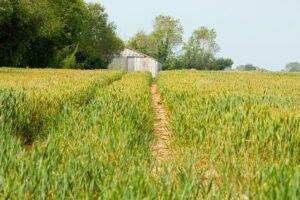In the center is the fallow land covered with soil
Next year, the conditions for fallow areas with soil cover that can be accounted for in HMKÁ 8 will be changed.

(Photo: Pixabay)
Therefore, farmers should pay special attention to the crop rotation rules. In the fall of 2023, a question of utmost importance for farmers is which areas in 2024 will be considered fallow areas with soil cover that can be accounted for in HMKÁ 8. Looking to the future, the European Commission does not see it as necessary for farmers to be able to produce crops for food purposes on their fallow land, and to be able to include them in HMKÁ 8 at the same time. It is therefore important that farmers plan their next year’s sowings in such a way that they comply with the rules for crop rotation according to HMKÁ 7 and non-productive areas according to HMKÁ 8. An area left fallow is considered to be an area on which no crops are sown or planted or harvested between January 1 and August 31, and on which farmers can only perform cleaning mowing and mechanical weeding. The use of pesticides is also not allowed, similar to the practice of areas of ecological importance (EFA) already used in greening.
The fallow area that can be accounted for in HMKÁ 8 must have some kind of soil cover during the rest period
The most useful method of mulching the fallow area from the point of view of the soil is the sown/planted ground cover vegetation. Farmers can choose from a variety of plants, many of which can serve as acceptable cover crops on their own, while some can only be used in combination with other plants. For example, white-flowered sweet lupins, alfalfa and many other plants can be sown alone as cover crops, while turnips, fodder beets and chicory can only be used together with other plants.
Until April 15, farmers can sow or plant a bee pasture or wildflower mix, many of which are already known from AKG
A wildflower mix is introduced as a new element to expand biodiversity and arthropod habitat. Farmers can also leave stubble residues and spontaneously appearing green vegetation, but must prevent flowering by mowing or crushing the stems. It is important to point out that it is forbidden to use plant protection agents, including coated seeds, on fallow areas accounted for under HMKÁ 8. In these areas, support tied to production cannot be used in the current year.
AM
Related news
AM: Government helps farmers with a loan moratorium
🎧 Hallgasd a cikket: Lejátszás Szünet Folytatás Leállítás Nyelv: Auto…
Read more >More than 100 Hungarian farmers also demonstrated in Brussels
🎧 Hallgasd a cikket: Lejátszás Szünet Folytatás Leállítás Nyelv: Auto…
Read more >NAK: Domestic producers await customers with an ample supply of all pine species
🎧 Hallgasd a cikket: Lejátszás Szünet Folytatás Leállítás Nyelv: Auto…
Read more >Related news
Crowds return to stores: margin cap and year-end preparations drive retail traffic
🎧 Hallgasd a cikket: Lejátszás Szünet Folytatás Leállítás Nyelv: Auto…
Read more >The second big rush in department stores comes between the two holidays
🎧 Hallgasd a cikket: Lejátszás Szünet Folytatás Leállítás Nyelv: Auto…
Read more >Pensioner food vouchers can be redeemed until December 31st
🎧 Hallgasd a cikket: Lejátszás Szünet Folytatás Leállítás Nyelv: Auto…
Read more >






